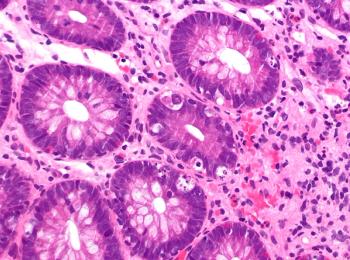
Venetoclax in the Context of the Current CLL Treatment Paradigm
In this podcast interview, Dr. William Wierda discusses the role of venetoclax in treating patients with chronic lymphocytic leukemia, particularly in light of recent trial results.
Today we are speaking with William Wierda, MD, PhD, who specializes in the treatment of leukemia at the M.D. Anderson Cancer Center, about venetoclax for chronic lymphocytic leukemia (CLL) in the context of currently available CLL therapies.
Oncotherapy Network:You and your colleagues recently presented the results of a pivotal CLL study (M13-982) of venetoclax at the annual meeting of the Society of Hematologic Oncology (SOHO). First, can you tell us how venetoclax is thought to work and why it could be effective in treating CLL?
Dr. Wierda: Sure. There is a protein called BCL-2 and it belongs to a family of proteins that participate in cell life and death. BCL-2 participates in prolonging the survival of cells. BCL-2 is overexpressed in patients’ CLL cells, and venetoclax is a small molecule inhibitor of BCL-2. So, when you expose cells to venetoclax, the BCL-2 is blocked and it favors the stoichiometry of the protein in the cell towards apoptosis or cell death. This method of killing CLL cells is independent of p53 and it is different than most of the other ways we treat CLL. For example, chemotherapy or the small molecule inhibitors of the B-cell receptor pathway do not act by similar mechanism as venetoclax, so it is a unique mechanism of action and the cells are exquisitely sensitive to killing when exposed to this BLC-2 inhibitor. The drug’s activity in treating CLL has been demonstrated in phase I and II clinical trials in patients who have relapsed CLL, as well as in patients who have relapsed and refractory disease with a 17p deletion, which is a high-risk feature in CLL. There have also been trials looking at venetoclax in the frontline and salvage settings in combination with CD20 antibodies. So there are a number of trials that have demonstrated activity as both a monotherapy and in combination, and some of those are ongoing. It is a very active and potent agent against CLL cells and is able to achieve deep remissions in treated patients, even as a monotherapy treatment and in those patients who have high-risk features and usually don’t have good responses to standard treatments, like the 17p population.
Oncotherapy Network:Can you tell us about the design of the trial you recently presented and the latest update from that trial?
Dr. Wierda: The current trial that was updated at the SOHO meeting is a phase II clinical trial of relapsed patients with 17p deletion, which is a high-risk population of patients. The original phase II clinical trial was the pivotal trial that led to U.S. Food and Drug Administration approval for venetoclax in the relapsed 17p population. That original trial had 107 patients and demonstrated activity in terms of response rate and durable remissions with venetoclax monotherapy. The update that was presented at SOHO was the trial where an additional 51 patients had been added as a safety expansion and for which there were outcomes data. So, 158 patients in total were presented in this update, all of whom had relapsed CLL and 17p deletion, at least on initial enrollment. This phase II trial essentially demonstrated, in this relapsed population, a response rate overall of 77% and a 20% complete response or complete remission with incomplete recovery of counts. So clearly there is monotherapy activity in this high-risk group and there is durability to these responses; the estimated median progression-free survival was 27 months and the median overall survival has not yet been reached. The other aspect we evaluated on this trial was minimal residual disease (MRD). Patients had MRD evaluated in blood and/or in bone marrow, and while not all of the patients had MRD data available, for those who did, there was about a 40% MRD-negative rate in the blood. By methodology that has a sensitivity of 10-4, and about 24% of patients who were evaluated in bone marrow were MRD-negative. These MRD-negative responses also correlated with longer duration of response. Therefore, the update was with additional patients and also confirmed the activity and demonstrated very deep remissions associated with treatment.
Oncotherapy Network: How do you see venetoclax fitting into the treatment paradigm for CLL, in the context of other currently available therapies for relapsed and refractory CLL?
Dr. Wierda: We should first touch on the toxicity associated with venetoclax. Because it is such a potent inducer of apoptosis and potently kills leukemic cells, you have to start the treatment at a very low dose and escalate over about a month to safely get patients started on treatment and to avoid significant tumor lysis. There is some close monitoring associated with that initiation and escalation. For the most part, you can safely get patients started on treatment and once they are up to their intended treatment dose, which is 400 milligrams daily, it is very well tolerated with some occasional cytopenias that need to be managed in the long term with growth factor support or with dose adjustment.
There are ongoing phase III trials with combinations, both in the frontline and salvage setting. In the frontline setting, venetoclax has been combined with obinutuzumab, a CD20 antibody. In the salvage setting, we are expecting results any day now from the MURANO trial, in which venetoclax was combined with rituximab. That trial compared efficacy of venetoclax with rituximab versus bendamustine plus rituximab. I am expecting that we will see improved outcomes in those phase III trials, favoring the venetoclax-containing arms. At M.D. Anderson we are working on small molecule inhibitor combinations, so we have a trial that is open for patients in the frontline and salvage settings to receive venetoclax plus ibrutinib. Others have looked at small inhibitor combinations and combinations with CD20 antibodies. Because of the depth of remission that we are seeing with venetoclax, I am expecting that it will be a very useful drug in combination with other small molecule inhibitors, with an intent to treat the patients to a good response so that we can then interrupt the treatment or give patients a treatment break. Right now, in patients who go on ibrutinib monotherapy, for example, the remissions are typically not deep and patients have to remain on an indefinite treatment. I think venetoclax may provide an opportunity to achieve good, deep remissions where we can offer a treatment break for patients and also achieve what we are intending to achieve, with the expectation to retreat patients when their disease relapses.
OncoTherapy Network: Thank you so much for joining us today Dr. Wierda!
Dr. Wierda: Thank you!
Newsletter
Stay up to date on recent advances in the multidisciplinary approach to cancer.
















































































